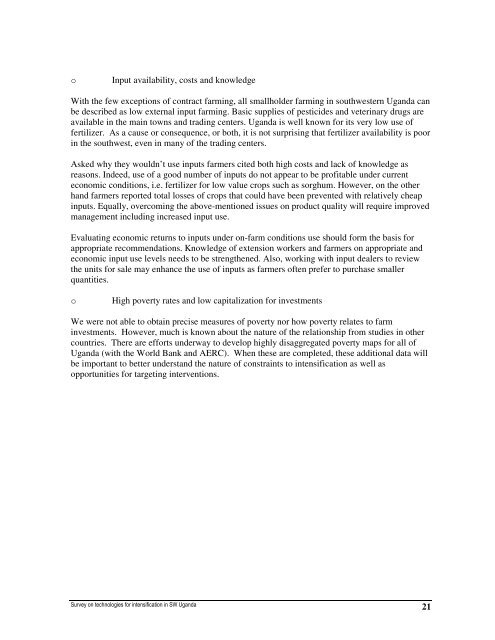Technologies for intensification in SW Uganda ... - Foodnet - cgiar
Technologies for intensification in SW Uganda ... - Foodnet - cgiar
Technologies for intensification in SW Uganda ... - Foodnet - cgiar
You also want an ePaper? Increase the reach of your titles
YUMPU automatically turns print PDFs into web optimized ePapers that Google loves.
o Input availability, costs and knowledge<br />
With the few exceptions of contract farm<strong>in</strong>g, all smallholder farm<strong>in</strong>g <strong>in</strong> southwestern <strong>Uganda</strong> can<br />
be described as low external <strong>in</strong>put farm<strong>in</strong>g. Basic supplies of pesticides and veter<strong>in</strong>ary drugs are<br />
available <strong>in</strong> the ma<strong>in</strong> towns and trad<strong>in</strong>g centers. <strong>Uganda</strong> is well known <strong>for</strong> its very low use of<br />
fertilizer. As a cause or consequence, or both, it is not surpris<strong>in</strong>g that fertilizer availability is poor<br />
<strong>in</strong> the southwest, even <strong>in</strong> many of the trad<strong>in</strong>g centers.<br />
Asked why they wouldn’t use <strong>in</strong>puts farmers cited both high costs and lack of knowledge as<br />
reasons. Indeed, use of a good number of <strong>in</strong>puts do not appear to be profitable under current<br />
economic conditions, i.e. fertilizer <strong>for</strong> low value crops such as sorghum. However, on the other<br />
hand farmers reported total losses of crops that could have been prevented with relatively cheap<br />
<strong>in</strong>puts. Equally, overcom<strong>in</strong>g the above-mentioned issues on product quality will require improved<br />
management <strong>in</strong>clud<strong>in</strong>g <strong>in</strong>creased <strong>in</strong>put use.<br />
Evaluat<strong>in</strong>g economic returns to <strong>in</strong>puts under on-farm conditions use should <strong>for</strong>m the basis <strong>for</strong><br />
appropriate recommendations. Knowledge of extension workers and farmers on appropriate and<br />
economic <strong>in</strong>put use levels needs to be strengthened. Also, work<strong>in</strong>g with <strong>in</strong>put dealers to review<br />
the units <strong>for</strong> sale may enhance the use of <strong>in</strong>puts as farmers often prefer to purchase smaller<br />
quantities.<br />
o High poverty rates and low capitalization <strong>for</strong> <strong>in</strong>vestments<br />
We were not able to obta<strong>in</strong> precise measures of poverty nor how poverty relates to farm<br />
<strong>in</strong>vestments. However, much is known about the nature of the relationship from studies <strong>in</strong> other<br />
countries. There are ef<strong>for</strong>ts underway to develop highly disaggregated poverty maps <strong>for</strong> all of<br />
<strong>Uganda</strong> (with the World Bank and AERC). When these are completed, these additional data will<br />
be important to better understand the nature of constra<strong>in</strong>ts to <strong><strong>in</strong>tensification</strong> as well as<br />
opportunities <strong>for</strong> target<strong>in</strong>g <strong>in</strong>terventions.<br />
21
















